A behind-the-scenes look at Leroy Merlin's digital transformation
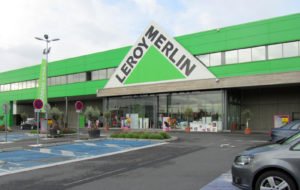
A behind-the-scenes look at Leroy Merlin's digital transformation
Article published by JOURNAL DU NET on 17 June 2014
Read on the Journal du Net website
A BEHIND-THE-SCENES LOOK AT LEROY MERLIN'S DIGITAL TRANSFORMATION
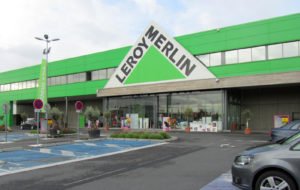
To date, Leroy Merlin's virtualisation project has been rolled out in two thirds of its stores, with completion slated for early 2015. © Alain Clapaud / JDN
Leroy Merlin is France's leading DIY chain. A defining feature of its 123 stores in France is that they all have a different IT infrastructure. "Leroy Merlin opens three new stores every year," explains Franck Drécourt, CIO at Leroy Merlin. "When we are looking to implement an innovation, we either try it out in an existing store to see how they manage the change, or we test it in a new store with a new team to see how the innovation will be received." The 12,000 m² store in Gonesse with its 121 employees was chosen to be the pilot for the virtualised desktop project in 2010.
MOBILE OFFICE - CREATING PC-FREE WORKSTATIONS
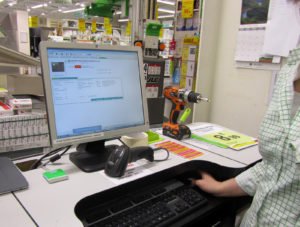
"Deployment was fairly time-consuming, because each workstation contains around 100 applications," advises Franck Drécourt. "Once the virtualisation process was completed, we replaced the workstations with thin clients." © Alain Clapaud / JDN
The standard workstations used at the customer information desks in Leroy Merlin stores are thin clients with a contactless smart card reader. Sales advisors open a session with their access card, and their session will then remain open regardless of which terminal they use in the store. Sales advisor Perrine explains the benefits of this particular strategy: "Mobile offices are highly practical. When the computer at the information desk is already being used, you can go to another terminal and instantly call up your session with the badge."
Sales advisors can follow their customers up and down the aisles without losing the details of the order created on the initial workstation. Workstations were virtualised with the Citrix XenApp solution, which was deployed in the Leroy Merlin data centre in northern France.
DIGITAL TABLETS: A LOGICAL EXTENSION TO VIRTUALISED DESKTOPS
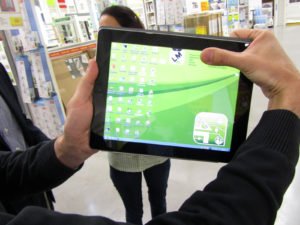
The Citrix client's compatibility with several platforms ensured a wide choice of tablets: the iPad Mini and more recently Android tablets. © Alain Clapaud / JDN
Since the desktop virtualisation solution chosen by Leroy Merlin's CIO was available for both smartphones and tablets, Sébastien Saint-Martin, director of the Gonesse store, took advantage of the opportunity to deploy touch tablets among his sales advisors: "I went for the iPad two years ago. I bought five iPads to try them out in the store. Sales advisors found them too heavy, so I chose the iPad Mini instead. The important thing in my eyes is not the actual tool, but giving the sales force more mobility." Approximately 15 iPad Minis have gradually been handed out to sales advisors in the Gonesse store, despite the chain's recent decision to use Android tablets.
APPLICATIONS HAVE HAD TO BE ADAPTED TO TABLETS
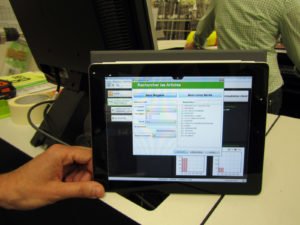
Leroy Merlin has adapted its sales management software to give advisors tablet access. © Alain Clapaud / JDN
Leroy Merlin is not only developing its website in-house, but also its sales management software. The sales management application, called Pyxis, is the most important tool for sales advisors. The problem is that it was not originally designed to run on tablets, as Franck Drécourt explains: "The Pyxis architecture was defined in 2005, with the software developed on the Eclipse RCP." Leroy Merlin's developers were faced with the task of virtualising what was originally a thick client application. "We used the Citrix Mobile SDK framework to improve the interface. Very few people use this SDK, and we had a bit of trouble finding support, but we are highly satisfied with the result," adds Franck Drécourt.
VIRTUAL DESKTOPS SPAWN A BYOD PHENOMENON AT LEROY MERLIN
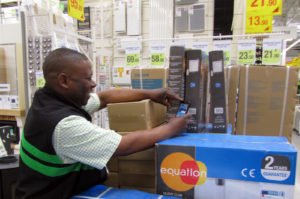
Employees use the ScanRef business application on their own phones, such as for scanning barcodes. © Alain Clapaud
The director of the Leroy Merlin store in Gonesse may believe that tablets are the best tool for improving the efficiency of the sales advisors, but they have already adopted mobile offices on their smartphones. All advisors use the ScanRef app on their phone to scan barcodes and check stock levels and prices. Management has pounced on the BYOD phenomenon. "The next version of ScanRef will display the competition's prices," adds Franck Drécourt. Employees' mass uptake of smartphones and tablets has consigned the rugged Motorola PDAs to the history books, which were previously used to update stock in the aisles.
WI-FI IS BECOMING ESSENTIAL FOR BOTH CUSTOMERS AND SALES STAFF
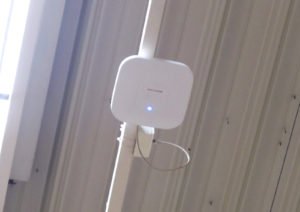
The Gonesse store features approximately 20 Wi-Fi antennas. © Alain Clapaud / JDN
The Gonesse store now offers Wi-Fi access in response to the increasing importance of handheld devices in the sales advisors' work. Around 20 antennas are required to ensure good connectivity throughout the 12,000 m² store. The network is open to both Leroy Merlin employees and customers. "We know that people compare prices on their smartphone," admits Franck Drécourt, "so we would rather that they stay in the store while doing so, instead of going to our competitors!" Tip: if you find the same product being sold for less elsewhere, show your smartphone to one of the sales advisors, since they are allowed to bring the price into line with the competition...
ELECTRONIC LABELS: A RESPONSE TO CROSS-CHANNEL MARKETING
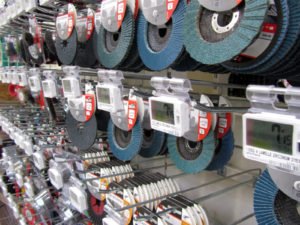
Leroy Merlin Gonesse has started using Pricer smart labels. © Alain Clapaud / JDN
Leroy Merlin has re-launched its smart label strategy in response to the showrooming trend and especially those customers who are much more inclined to compare prices between different retailers. Leroy Merlin Gonesse started rolling out Pricer smart labels in its tools aisle, before moving onto the paint aisle, where 4,000 to 5,000 labels alone have been reprinted in the last three months. "Cross-channel marketing has prompted this acceleration," explains Frank Drécourt. "Ever since we and our competitors started selling products online, prices have been changing more quickly." Electronic labels are the solution to this acceleration.
LABELS ARE UPDATED EACH HOUR
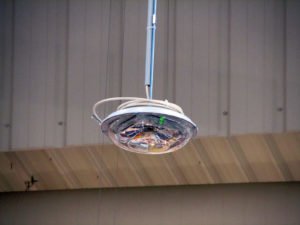
Electronic labels improve inventory management, since the number of items in stock is also shown on the label. © Alain Clapaud / JDN
The problem with electronic labels continues to be their high deployment cost, which runs into several hundreds of thousands of euros for each store. "We began implementing labels four years ago, but there was no clear ROI," explains Frank Drécourt. "The reason why we have started deploying labels again this year is because prices now change much faster." In addition to allowing us to update prices every hour, electronic labels improve inventory management, since the number of items in stock is also shown on the label. E-labels also pave the way for geolocating items in the aisles. Geolocation information is currently entered manually, but it is very useful for calculating picking routes (when preparing orders placed over the Internet).
A DOWNSIZED IT ROOM
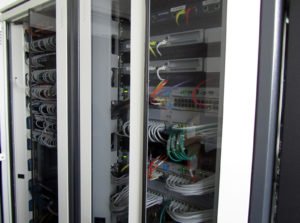
A store's IT room practically houses nothing more than the networking and telecoms hardware. © Alain Clapaud
As a result of the virtualisation strategy, a store's IT room practically houses nothing more than the networking and telecoms hardware. All that remains at the Gonesse store is two servers. "We have centralised the main applications at our data centre," advises Franck Drécourt. "Some servers are left, particularly for the application that centralises cash desk data, a file server and the 3D kitchen design application. Two servers are enough to cover those requirements." All Citrix servers are hosted in the data centre, and the CIO is looking to go even further for all new stores: "They start without any servers and merely use laptops."
MULTIPLE DEVICES EVEN ON THE WALLS
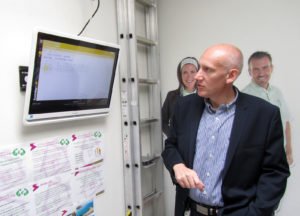
Desktop virtualisation also serves disaster recovery planning (DRP) needs. © Alain Clapaud / JDN
The Mobile Office application is available on the thin clients at the customer information desks, as well as on handhelds and even the Android screens in the stores' offices. A version has also been created for laptops called "LM at Home". This version is used when launching new stores, since there is no infrastructure, and also by sales advisors when travelling to sites. Desktop virtualisation also serves disaster recovery planning (DRP) needs. If a store's IT room is destroyed, business can continue uninterrupted thanks to "LM at Home", without any need for an IT infrastructure.
INVOICE PRINTING TERMINALS: A STORE-INSPIRED INNOVATION
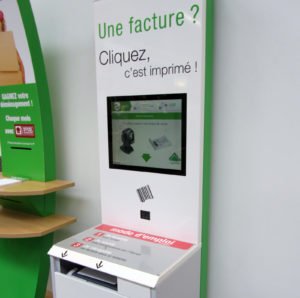
L'idée de la borne d'impression de factures est née à Gonesse, et a rapidement été diffusée dans le reste du réseau. © Alain Clapaud
The idea for an invoice printing terminal emerged at the Gonesse store and quickly spread to the rest of the network. © Alain Clapaud
Leroy Merlin's senior management and IS Division believe in giving the stores considerable latitude, which enables them to gear their merchandising towards the specifics of the local market and promotes innovation. That is how the idea for an invoice printing terminal behind the cash desks came about. Printing terminals are an effective way of saving time for professionals. The idea emerged at the Gonesse store and quickly spread to the rest of the network. "The store's teams are the ones that asked for the terminal to be installed," recalls Franck Drécourt. "We created it for them. We trial two or three ideas for each store opened. This means that there are some flops, but it does not matter. The main thing is that the entire company is driven by innovation," concludes the CIO.
CUSTOMER GEOLOCATION REMAINS IN TESTING
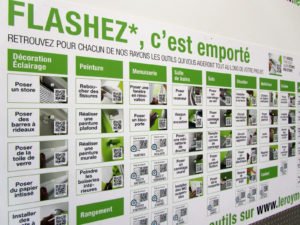
Leroy Merlin is testing a dozen geolocation ideas. © Alain Clapaud / JDN
A board at the entrance to the Gonesse store guides customers to the required aisle using QR codes. The system is simple, but the IS Division is actively working on more sophisticated concepts. "We are trying out several geolocation ideas in our stores," explains Frank Drécourt, "Wi-Fi-based geolocation is not accurate enough. In some stores, we are trialling Bluetooth Low Energy with Cisco. We are also testing Apple's iBeacon technology. In all, a dozen geolocation projects are in the pipeline, but no solution has yet proven to be truly effective."